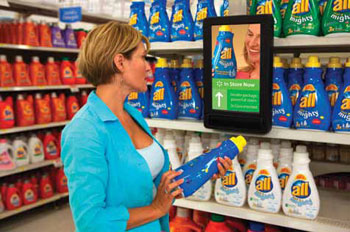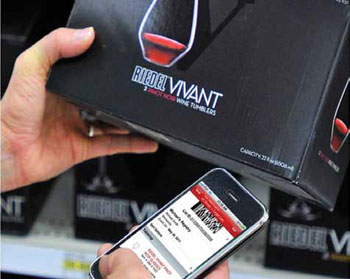LEVERAGING DIGITAL SIGNAGE AND MOBILE IN-STORE

The Opportunity for Place-Based Mobile Loyalty
As more functionality evolves for mobile in-store, the opportunity for loyalty and shopper personalization is thrilling. What could this mean for your digital signage strategy?
In an article for the Digital Signage Best Practices Guide early this year, I focused on mobile and predicted that 2010 would open the door to some fairly radical new capabilities for it. Now, looking at 2010 Q4, and looking toward 2011, progress has outpaced my expectations. To make my point, let me first start with a story.
A few months ago, I finally landed a meeting with the CMO of a top 10 retailer to discuss their plans for in-store experience design. This was a brand considered to be a savvy early innovator in the digital signage landscape. As I was discussing some of the emerging technologies that we’re excitedly exploring, the CEO held up his hand to stop me and said, “I got it. That’s stuff’s cool, but I’ve been burned enough by being the first to install a technology that falls to pieces in-store. Personally, my bets are on mobile.”
A month later, while meeting with a top executive of another top 10, I heard it again. She shared that her most important question right now was whether they should test mobile in-store prior to trying digital signage or interactive. It was a darned good question.
THE NEED FOR DIGITAL BRIDGES

Retailers have realized the possibilities that digital signage provides — now its time to use it to interact even more with customers.
A daily selection of the top stories for AV integrators, resellers and consultants. Sign up below.
For ten years now research has shown us that shoppers desperately want better bridges between online and in-store. Today, they are more frustrated than ever about this. In fact, it comes up in every single research effort that we undertake for a retail client.
The reason for the frustration is that people have grown accustomed to having personal communications, incentives, and experiences online. Online shopping functionality continues to evolve, and people can’t comprehend why similar tools can’t be accessed in-store.
On the retail side, this shopper frustration remains unaddressed because the requirements involved to create the platforms to do this can be expensive, time consuming, and scary. Any time that IT is asked to integrate shopper data, transactional data, external ASP’s, POS systems, and in-store web access, data security and potential points of vulnerability become a key concern. Unfortunately, it’s often enough of one to shut down a shopper innovation.
ENTER PLACE-BASED MOBILE LOYALTY
Location-based mobile platforms are here and many such as Four Square have started to take off. Shopkick and similar mobile platforms have also shown up that incentivize people to check in specifically at retail stores. People turn on their Bluetooth, touch the app, and all kinds of special promotions are presented for redemption at the register. The next step for these mobile store apps is to make the communications personal and targeted, and this is where things get interesting.
While all of this has been going on, a new genre of loyalty platform has emerged that allows a person to store all of their retail loyalty cards on their mobile phone. This feature combined with a location-based app could allow people to opt in and receive personalized, targeted messaging any time that they “check in” at a store.
But, there is a snag. No one is going to buy in to being tracked via a mobile phone unless they are highly incentivized, trust the source, and know that their participation is going to give them something that they highly value. Being able to receive and redeem targeted incentives just by walking in a store while not carrying any more loyalty cards would certainly be a great start. However, sweetening the pot for the shopper to buy in would be a good move. Here’s some we’re thinking about:
■ Send real-time feedback to corporate — Give shoppers the ability to hit a button on their phone and send constructive feedback on their shopping experience.
■ Wayfinding — Integrate a product location feature and mobile associate call button.
■ Social shopping — Enable people to tie their favorite friends into their loyalty profile. Then, give their social community various levels of information sharing such as locate friends in-store, share recent purchases, and post feedback on products.
■ Mobile purchase — Another mobile feature making great strides, tying all of the above into the ability to purchase via the phone and sync to loyalty data would be the icing on the cake.
HOW THIS BENEFITS DIGITAL SIGNAGE

Mobile coupons are one way that customers can interact more with their favorite retail store. Photo courtesy of Target.
Back to our retailer’s question on if mobile should be tested prior to digital signage: My honest answer is that this depends on what the retailer is looking to do and how it ranks against other priorities.
This Nirvana picture of mobile personalization is only one of many tools available for digital experience design in-store — and not everyone is going to opt into it. It will never take the place of the ability to feature a can’t-miss promotion on a large screen. It can’t serve as a touchscreen for doing detailed, collaborative project or product consultations with an associate. But it does enable that highly coveted digital bridge between online and in-store while mitigating the infrastructure, cost, risk, and security concerns for the retailer.
No matter what your role in the digital signage ecosystem, I challenge you to spend the time to understand what’s happening with mobile personalization and have an informed point of view on what to do with it. Deployed as a helpful shopper tool that provides quality service and rewards, there’s plenty of upside for us all.
Five things to Watch in Mobile-Digital signage crossover For 2011
1 Place-Based Mobile Loyalty: Loyalty cards will go mobile and combine with location-based applications to provide personalized communications and incentives.
2 Product Information: Via 2D barcodes and new genres of smart tags, shoppers will be able to scan and learn more about a product, see reviews, and potentially compare the price against other retail stores.
3 Interactivity: Today’s interactive screens will be utilized for more complex shopper engagements and the mobile phone will become the method to pull quick snippets of information to a shopper in real-time.
4 Wayfinding: Also utilizing location-based functionality, people will be able to locate products based on where they are standing in the store.
5 Training/Employee Sales Tools: More mobile applications will emerge that associates utilize to help, engage, and better sell.
Laura Davis-Taylor is VP of Global Retail Strategy for Creative Realities, a global experiential branding and marketing firm that specializes in creating wow environments and customer experiences. Laura is a yearly co-chair of the Digital Signage Expo, chair of the POPAI Digital Signage Advocacy Committee, board member of The Digital Signage Experts Group, and an “expert resource” lecturer and workshop teacher. In 2007, she co-authored the first industry field book, Lighting up the Aisle: Principles and Practices for In-Store Digital Media (http://www.lightinguptheaisle.com).
Laura Davis-Taylor is chief strategy officer of InReality, a venue analytics platform that makes generating the most important placebased metrics easy. Their platform harnesses most any IoT tracking, measurement and influencing technologies to deliver the KPIs you need most.

